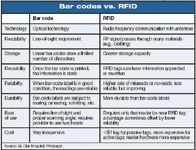Tag team: Will bar-coding and RFID coexist?
At St. Clair Hospital in Pittsburgh, medications are labeled with bar codes and patients' wristbands are tagged with radio frequency identification (RFID) microchips that relay information to handheld devices to ensure that patients receive the correct medication. Across town, Jefferson Regional Medical Center has placed bar codes on drugs and patient IDs but has not adopted RFID technology.
At St. Clair Hospital in Pittsburgh, medications are labeled with bar codes and patients' wristbands are tagged with radio frequency identification (RFID) microchips that relay information to handheld devices to ensure that patients receive the correct medication. Across town, Jefferson Regional Medical Center has placed bar codes on drugs and patient IDs but has not adopted RFID technology.
Throughout the country, hospitals are grappling with adoption of point-of-care technology to ensure safe medication administration. Giving a traceable individual identity to medications to assist with safe drug delivery, not to mention to foil counterfeiters and avoid tampering and theft, has earned many advocates, ranging from the Food & Drug Administration to several industry groups.

St. Clair Hospital's implementation of bar-coding and RFID tagging is exceedingly uncommon in the industry. The 331-bed hospital places bar codes on medication packages and uses RFID tags for providers' name badges, patient wristbands, and certain equipment such as IV pumps and wheelchairs. Providers use a handheld device with a dual-mode scanner to read the bar codes and RFID tags, eliminating the need to purchase separate hardware.
"The price of RFID tags has dropped significantly, but not to the point where it's cost-effective to put them on medication packages," said Tom Ague, B.Pharm., executive VP and COO of St. Clair Hospital. "Putting an RFID tag on name badges and equipment does not cost a lot, but the payback is significant."
According to ASHP's director of pharmacy practice sections, Douglas Scheckelhoff, there continues to be a lot of interest in implementing bar-coding and RFID tagging. "Many healthcare systems are probably more realistic about the costs of implementing these systems now," he said. "Bar-coding has proven itself to be an effective means of identifying medications at the bedside; however, RFID still needs to be tested in the field to see whether it's going to be a superior means of identifying medications."
Technological tools
Bar-code scanning first debuted in 1974 at checkout counters, and within 10 years the black-and-white paper labels could be found on products in pharmacies and supermarkets. Until recently, the labels appeared on nearly every item with the exception of medications.
Within the past few years, at the urging of the FDA, bar codes have been placed on the majority of bulk medications and on individual drug packages in some hospital settings. In 2003, bar-coding entered the corridors of Pittsburgh's Jefferson Regional Medical Center. The labels are used on drugs and name badges, according to Terri Riskey, R.Ph., manager of pharmacy operations.
St. Clair and Jefferson represent a small universe of health systems using bar-coding. In 2005, 10% of hospitals had implemented bar-code medication administration, up from just 1.5% in 2002, according to an ASHP survey. The annual survey did not examine how many hospitals are using RFID technology, but most industry observers estimate that it is a small percentage.
By the end of the decade, 80% of hospitals with 100 beds or more are expected to be using bar-coding at the point of care, predicted Mark Neuenschwander, a recognized expert in medication-use automation based in Bellevue, Wash. "RFID is probably never going to displace the bar code, at least not for many years," he said. "RFID is definitely a sexier technology than bar-coding, but the simpler technology is sometimes the preferable method."